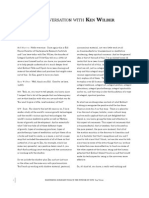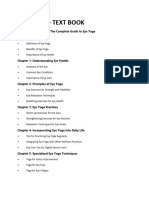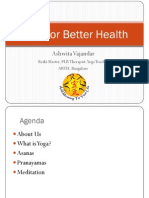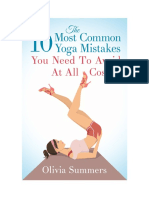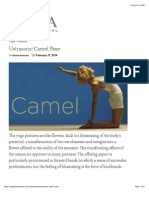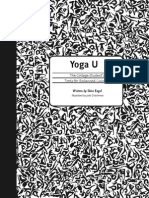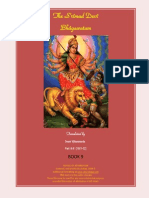Introduction To Yoga
Introduction To Yoga
Uploaded by
Santa LaneCopyright:
Available Formats
Introduction To Yoga
Introduction To Yoga
Uploaded by
Santa LaneOriginal Title
Copyright
Available Formats
Share this document
Did you find this document useful?
Is this content inappropriate?
Copyright:
Available Formats
Introduction To Yoga
Introduction To Yoga
Uploaded by
Santa LaneCopyright:
Available Formats
www.wellbeingart.
com
Introduction to Yoga
www.wellbeingart.com
1. What Is Yoga?
The word yoga, from the Sanskrit word yuj means to yoke or bind and is often
interpreted as union or a method of discipline. A male who practices yoga is called a
yogi, a female practitioner, a yogini.
The Indian sage Patanjali is believed to have collated the practice of yoga into the Yoga
Sutra an estimated 2,000 years ago. The Sutra is a collection of 195 statements that
serves as a philosophical guidebook for most of the yoga that is practiced today. It also
outlines eight limbs of yoga:
the yamas (restraints), niyamas (observances), asana (postures), pranayama (breathing
),pratyahara (withdrawal of senses), dharana (concentration), dhyani (meditation),
and samadhi(absorption). As we explore these eight limbs, we begin by refining our
behavior in the outer world, and then we focus inwardly until we reach samadhi
(liberation, enlightenment).
Today most people practicing yoga are engaged in the third limb, asana, which is a
program of physical postures designed to purify the body and provide the physical
strength and stamina required for long periods of meditation.
2. What Does Hatha Mean?
The word hatha means willful or forceful. Hatha yoga refers to a set of physical
exercises (known as asanas or postures), and sequences of asanas, designed to align
your skin, muscles, and bones. The postures are also designed to open the many
channels of the bodyespecially the main channel, the spineso that energy can flow
freely.
Hatha is also translated as ha meaning sun and tha meaning moon. This refers to
the balance of masculine aspectsactive, hot, sunand feminine aspectsreceptive,
cool, moonwithin all of us. Hatha yoga is a path toward creating balance and uniting
opposites. In our physical bodies we develop a balance of strength and flexibility. We
also learn to balance our effort and surrender in each pose.
Hatha yoga is a powerful tool for self-transformation. It asks us to bring our attention to
our breath, which helps us to still the fluctuations of the mind and be more present in the
unfolding of each moment.
www.wellbeingart.com
3. What Does Om Mean?
Om is a mantra, or vibration, that is traditionally chanted at the beginning and end of
yoga sessions. It is said to be the sound of the universe. What does that mean?
Somehow the ancient yogis knew what scientists today are telling usthat the entire
universe is moving. Nothing is ever solid or still. Everything that exists pulsates, creating
a rhythmic vibration that the ancient yogis acknowledged with the sound of Om. We
may not always be aware of this sound in our daily lives, but we can hear it in the
rustling of the autumn leaves, the waves on the shore, the inside of a seashell.
Chanting Om allows us to recognize our experience as a reflection of how the whole
universe movesthe setting sun, the rising moon, the ebb and flow of the tides, the
beating of our hearts. As we chant Om, it takes us for a ride on this universal
movement, through our breath, our awareness, and our physical energy, and we begin
to sense a bigger connection that is both uplifting and soothing.
4. Do I Have to Be Vegetarian to Practice Yoga?
The first principle of yoga philosophy is ahimsa, which means non harming to self and
others. Some people interpret this to include not eating animal products. There is
www.wellbeingart.com
debate about this in the yoga communityI believe that it is a personal decision that
everyone has to make for themselves. If you are considering becoming a vegetarian, be
sure to take into account your personal health issues as well how your choices will
affect those with whom you live. Being a vegetarian should not be something that you
impose on othersthat kind of aggressive action in itself is not an expression of
ahimsa.
5. How Many Times Per Week Should I Practice?
Yoga is amazingeven if you only practice for one hour a week, you will experience
the benefits of the practice. If you can do more than that, you will certainly experience
more benefits. I suggest starting with two or three times a week, for an hour or an hour
and a half each time. If you can only do 20 minutes per session, thats fine too. Dont let
time constraints or unrealistic goals be an obstacledo what you can and dont worry
about it. You will likely find that after a while your desire to practice expands naturally
and you will find yourself doing more and more.
6. How Is Yoga Different From Stretching or Other Kinds
of Fitness?
www.wellbeingart.com
Unlike stretching or fitness, yoga is more than just physical postures. Patanjalis eightfold path illustrates how the physical practice is just one aspect of yoga. Even within the
physical practice, yoga is unique because we connect the movement of the body and
the fluctuations of the mind to the rhythm of our breath. Connecting the mind, body, and
breath helps us to direct our attention inward. Through this process of inward attention,
we learn to recognize our habitual thought patterns without labeling them, judging them,
or trying to change them. We become more aware of our experiences from moment to
moment. The awareness that we cultivate is what makes yoga a practice, rather than a
task or a goal to be completed. Your body will most likely become much more flexible by
doing yoga, and so will your mind.
7. Is Yoga a Religion?
Yoga is not a religion. It is a philosophy that began in India an estimated 5,000 years
ago. The father of classical ashtanga yoga (the eight-limbed path, not to be confused
with Sri K. Pattabhi Jois Ashtanga yoga) is said to be Patanjali, who wrote the Yoga
Sutra. These scriptures provide a framework for spiritual growth and mastery over the
physical and mental body. Yoga sometimes interweaves other philosophies such as
Hinduism or Buddhism, but it is not necessary to study those paths in order to practice
or study yoga.
It is also not necessary to surrender your own religious beliefs to practice yoga.
8. Im Not FlexibleCan I Do Yoga?
Yes! You are a perfect candidate for yoga. Many people think that they need to
be flexible to begin yoga, but thats a little bit like thinking that you need to be able to
play tennis in order to take tennis lessons. Come as you are and you will find that yoga
practice will help you become more flexible.
This newfound agility will be balanced by strength, coordination, and enhanced
cardiovascular health, as well as a sense of physical confidence and overall well-being.
www.wellbeingart.com
9. What Do I Need to Begin?
All you really need to begin practicing yoga is your body, your mind, and a bit of
curiosity. But it is also helpful to have a pair of yoga leggings, or shorts, and a t-shirt
thats not too baggy. No special footgear is required because you will be barefoot. Its
nice to bring a towel to class with you. As your practice develops you might want to buy
your own yoga mat, but most studios will have mats and other props available for you.
10. Why Are You Supposed to Refrain From Eating 2
3 Hours Before Class?
In yoga practice we twist from side to side, turn upside down, and bend forward and
backward. If you have not fully digested your last meal, it will make itself known to you
in ways that are not comfortable. If you are a person with a fast-acting digestive system
and are afraid you might get hungry or feel weak during yoga class, experiment with a
light snack such as yogurt, a few nuts, or juice about 30 minutes to an hour before
class.
You might also like
- 20 Tablets of The Law of TimeDocument132 pages20 Tablets of The Law of TimeCadu Vieira100% (12)
- Gateway 2021 Large LabelsDocument114 pagesGateway 2021 Large LabelsVincent Baker100% (2)
- Mastering The Power of Now Ken WilberDocument15 pagesMastering The Power of Now Ken WilberDianna100% (3)
- New Course in Reading Pali - James W Gair & W S Karunatillake - OCRDocument116 pagesNew Course in Reading Pali - James W Gair & W S Karunatillake - OCRChris Sprague100% (1)
- 100 Niche Ideas For Yoga TeachersDocument4 pages100 Niche Ideas For Yoga TeachersFabiana Mitsik67% (3)
- The Cave of The Ancients - Lobsang RampaDocument188 pagesThe Cave of The Ancients - Lobsang Rampaanimerulz001100% (2)
- Breath of Fire PDFDocument3 pagesBreath of Fire PDFRanocelnik100% (2)
- Life of Pi Analysis EssayDocument2 pagesLife of Pi Analysis Essayapi-358131223100% (1)
- Yoga Nidra Yogic Conscious Deep Sleep by Swami Jnaneshvara Bharati Homepage PDFDocument25 pagesYoga Nidra Yogic Conscious Deep Sleep by Swami Jnaneshvara Bharati Homepage PDFBianca TupinambáNo ratings yet
- Questions and Answers: 1. What Is Yoga?Document41 pagesQuestions and Answers: 1. What Is Yoga?Gopi RamalingamNo ratings yet
- YOGA Home Practice Handbook (May 2020) PDFDocument9 pagesYOGA Home Practice Handbook (May 2020) PDFBubblyDeliciousNo ratings yet
- AllAboutYoga PDFDocument29 pagesAllAboutYoga PDFValeria BensoNo ratings yet
- Yoga Poses and What They AchieveDocument1 pageYoga Poses and What They AchieveVenketeshwar SwamiNo ratings yet
- How To Create A Yoga Sequence That Flows For New Yoga Teachers - The Yoga NomadsDocument6 pagesHow To Create A Yoga Sequence That Flows For New Yoga Teachers - The Yoga Nomadsmarialepv0% (1)
- Yoga Teacher Training Curriculum & Program - Himalayan Yoga Academy (Rishikesh, India) - 2012-13Document9 pagesYoga Teacher Training Curriculum & Program - Himalayan Yoga Academy (Rishikesh, India) - 2012-13Anastasia Kurdina0% (2)
- Just-for-Fun Yoga and Anatomy Quiz Answer Sheet With ResultsDocument6 pagesJust-for-Fun Yoga and Anatomy Quiz Answer Sheet With ResultsGovind KaNo ratings yet
- Yoga For Glowing Skin 1. Breathing Exercise:: 2. Shirshasana (Headstand)Document7 pagesYoga For Glowing Skin 1. Breathing Exercise:: 2. Shirshasana (Headstand)Anjali RaiNo ratings yet
- 3 Alignment Principles by TINT PDFDocument13 pages3 Alignment Principles by TINT PDFKani PolyNo ratings yet
- Lists of Asanas - How To & BenefitDocument48 pagesLists of Asanas - How To & BenefitPak Ananda100% (1)
- Yoga and Inner Ear Disorders 21Document4 pagesYoga and Inner Ear Disorders 21rajendraNo ratings yet
- YogaDocument60 pagesYogaФилип Павловић100% (4)
- Breaking Yoga PosesDocument14 pagesBreaking Yoga Posestruenaturals-1No ratings yet
- YogaDocument15 pagesYogaBashu Poudel100% (1)
- Yin Yoga For The KneesDocument3 pagesYin Yoga For The KneesGemma100% (1)
- 10 Yoga Poses To Prepare For Flying PigeonDocument6 pages10 Yoga Poses To Prepare For Flying Pigeonstudio1bcNo ratings yet
- 200 Hour Yoga Teacher Training in Rishikesh, IndiaDocument1 page200 Hour Yoga Teacher Training in Rishikesh, IndiaArogya Yoga School0% (2)
- Hot YogaDocument3 pagesHot YogaTom Matlack100% (2)
- Yoga Program Focused On Using Yoga Equipment Updated Version PDFDocument16 pagesYoga Program Focused On Using Yoga Equipment Updated Version PDFCarolina LinchNo ratings yet
- EYE YOGA E-BookDocument18 pagesEYE YOGA E-Bookdipjyotipatra100% (1)
- The Integrated Approach of Yoga Therapy For Good LifeDocument9 pagesThe Integrated Approach of Yoga Therapy For Good LifeChandra BalaNo ratings yet
- Project File YogaDocument27 pagesProject File Yogadaimond.noida100% (1)
- Yoga Therapy For Teachers D2 PDFDocument9 pagesYoga Therapy For Teachers D2 PDFAndreea Simona CosteNo ratings yet
- Sample TYT EbookDocument22 pagesSample TYT Ebookvvavadi100% (1)
- Yin 1Document93 pagesYin 1Tati AnaNo ratings yet
- Yoga Core Strength FoundationsDocument42 pagesYoga Core Strength FoundationsTest4D100% (1)
- Shape Shifter Yoga Starter ManualDocument25 pagesShape Shifter Yoga Starter ManualVernetteNg100% (1)
- Yoga For Better HealthDocument39 pagesYoga For Better HealthCservenák GáborNo ratings yet
- Eka Pada Sirsasana and VariationsDocument30 pagesEka Pada Sirsasana and VariationsLomombNo ratings yet
- Yoga SattvaDocument28 pagesYoga SattvaPrem NoorNo ratings yet
- Benefits of Yoga From HEAD To TOE (Based On Scientific Research)Document38 pagesBenefits of Yoga From HEAD To TOE (Based On Scientific Research)Ajay LochunNo ratings yet
- Fit Yoga Skillful SequencingDocument5 pagesFit Yoga Skillful SequencingVasudeva Ckshirasagar91% (11)
- Svastha Yoga of Krishnamacharya: Therapy ProgramDocument7 pagesSvastha Yoga of Krishnamacharya: Therapy ProgramUwe HeimNo ratings yet
- Vata Lifestyle Recommendation Flyer NCISMDocument6 pagesVata Lifestyle Recommendation Flyer NCISMDàrshâñ Prîñçè100% (1)
- Ashtanga - Ps.counted 3Document6 pagesAshtanga - Ps.counted 3JenniferNo ratings yet
- Sun Salutation: A3.1, B1.1 Grade 6 - YogaDocument8 pagesSun Salutation: A3.1, B1.1 Grade 6 - Yogaapi-454675280No ratings yet
- Yoga AsanaluDocument90 pagesYoga AsanaluDvs Ramesh100% (1)
- Iyengar Yoga and The Benefits of Using PropsDocument4 pagesIyengar Yoga and The Benefits of Using PropsBárbara AyalaNo ratings yet
- 038 Derk Steinberg Iyengar Yoga Therapy AIHM2017Document19 pages038 Derk Steinberg Iyengar Yoga Therapy AIHM2017rajendraNo ratings yet
- 14 Yoga For High Blood PressureDocument3 pages14 Yoga For High Blood PressurekumargautambkscNo ratings yet
- Yoga Starter SeqDocument15 pagesYoga Starter SeqErick JimenezNo ratings yet
- 10 Yoga Mistakes To Avoid (M)Document16 pages10 Yoga Mistakes To Avoid (M)pabloNo ratings yet
- Ustrasana - Camel Pose - Yoga International PDFDocument8 pagesUstrasana - Camel Pose - Yoga International PDFToreØrnNo ratings yet
- Yoga The Essence of LifeDocument233 pagesYoga The Essence of LifeErcan Can100% (2)
- Yoga For ThighsDocument23 pagesYoga For ThighsPawan Decent Guy0% (1)
- Essential Yoga - An Illustrated Guide To Over 100 Yoga Poses and Meditations (PDFDrive) PDFDocument428 pagesEssential Yoga - An Illustrated Guide To Over 100 Yoga Poses and Meditations (PDFDrive) PDFVeera Vardhan100% (3)
- Yoga Therapy For Teachers D1 PDFDocument18 pagesYoga Therapy For Teachers D1 PDFAndreea Simona Coste100% (1)
- Yoga Asana StickDocument27 pagesYoga Asana Stickluther blissetNo ratings yet
- 12 Basic Asanas That Will Help You Ease Into The Yoga RegimenDocument23 pages12 Basic Asanas That Will Help You Ease Into The Yoga RegimenANMOLNo ratings yet
- Yoga U-The College Students Tools For Balanced LivingDocument129 pagesYoga U-The College Students Tools For Balanced Livingapi-256142290No ratings yet
- Yoga To Your DayDocument105 pagesYoga To Your DayOscar FontrodonaNo ratings yet
- Sirsasana Father of All AsanasDocument2 pagesSirsasana Father of All AsanasHaseebNo ratings yet
- SCIATICA - Rev. Durga GlassonDocument25 pagesSCIATICA - Rev. Durga GlassonAissmsIomPuneNo ratings yet
- 215 Hatha Yoga Poses A4 PreviewDocument1 page215 Hatha Yoga Poses A4 PreviewsanjarshuhratovNo ratings yet
- Detailed Guide of 26 Bikram Yoga Poses & BenefitsDocument57 pagesDetailed Guide of 26 Bikram Yoga Poses & Benefitscbarriuso100% (1)
- YogaDocument100 pagesYogakeshavchainani90% (10)
- Kāyānupassanā Part IIDocument24 pagesKāyānupassanā Part IIbdhita dawNo ratings yet
- Imagination and Reality in Classical Indian Philosophy SyllabusDocument2 pagesImagination and Reality in Classical Indian Philosophy SyllabusCat PrueittNo ratings yet
- MensguideDocument267 pagesMensguideAnonymous tD1HSz3100% (1)
- Nazca MysteriesDocument17 pagesNazca MysteriesJah BillahNo ratings yet
- Meredith Monk - White Light FestivalDocument13 pagesMeredith Monk - White Light FestivalBen SpatzNo ratings yet
- A Buddha Within TathagatagarbhasutraDocument450 pagesA Buddha Within TathagatagarbhasutraalphabetaNo ratings yet
- The Pre-Gupta Period: By-Manish ShrivastavaDocument12 pagesThe Pre-Gupta Period: By-Manish ShrivastavaMayank DwivediNo ratings yet
- AKHIRAHDocument22 pagesAKHIRAHScoot QahNo ratings yet
- Devi Bhagavatam Book 9Document239 pagesDevi Bhagavatam Book 9Vikram Ramsoondur50% (4)
- Four-Protective-Meditations (English Version)Document24 pagesFour-Protective-Meditations (English Version)kolosrv2020No ratings yet
- Jin Sheng Yuan LyricsDocument1 pageJin Sheng Yuan LyricsJohn Vince Bigtas SabianoNo ratings yet
- Mohini Vidya Sadhana and Siddhi by A.L.BHAGWATDocument80 pagesMohini Vidya Sadhana and Siddhi by A.L.BHAGWATsharath kumar.r89% (18)
- Subjective Evolution of Consciousness by Srila Bhakti Raksak SridharDocument105 pagesSubjective Evolution of Consciousness by Srila Bhakti Raksak SridharAlexey GogolevNo ratings yet
- Ikinyarwanda - Amashuri Yisumbuye - Igitabo Cy'Umunyeshuri - Umwaka Wa 4Document352 pagesIkinyarwanda - Amashuri Yisumbuye - Igitabo Cy'Umunyeshuri - Umwaka Wa 4uwihalexie2050No ratings yet
- A Manual of Profound Meaning Four Stanzas On Samvega by Ledi SayadawDocument6 pagesA Manual of Profound Meaning Four Stanzas On Samvega by Ledi SayadawSwee Joo TanNo ratings yet
- E Lunar7 11Document2 pagesE Lunar7 11Stefaan Van NuffelNo ratings yet
- The Eight Verses of Training (Or Transforming) The MindDocument4 pagesThe Eight Verses of Training (Or Transforming) The Mindleo9122100% (2)
- Xi Wangmu: Shamanic Great Goddess of ChinaDocument11 pagesXi Wangmu: Shamanic Great Goddess of ChinaSofia BatalhaNo ratings yet
- 2.24.13 The Magical Buffet Interviews Growing Into God Author John R. MabryDocument3 pages2.24.13 The Magical Buffet Interviews Growing Into God Author John R. MabryQuestBooksNo ratings yet
- Gregory Schopen - The Lay Ownership of Monasteries and The Role of The Monk in Mūlasarvāstivādin MonasticismDocument47 pagesGregory Schopen - The Lay Ownership of Monasteries and The Role of The Monk in Mūlasarvāstivādin MonasticismƁuddhisterie2No ratings yet
- ThunderClap's Tulpa Creation GuideDocument13 pagesThunderClap's Tulpa Creation GuideGeorgeGeorgeNo ratings yet
- Chapter 18Document3 pagesChapter 18Griffin LowryNo ratings yet


